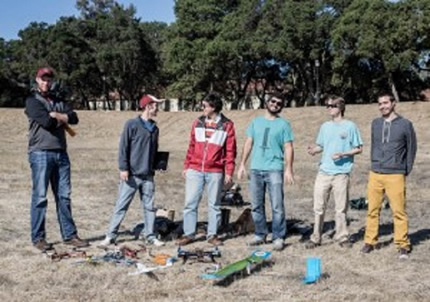Science, Technology, Engineering & Math | News
Stanford Aeronautics Classmates Build Their Own Drones
Student
teams
in a 10-week class at Stanford University's School
of Engineering build a
drone, an unmanned aerial vehicle (UAV), then compete with one another
to use
it.
It’s
the
perfect opportunity to not only learn the nuts and bolts
behind a fast-growing
technology, but also to apply that knowledge in a real-life situation.
"We
get
many students who are great at software and simulation, but they've
seldom
built anything," said Juan Alonso, an associate professor of aeronautics
and
astronautics at Stanford.
Alonso
began
teaching the class way back in 2002 along with Ilan Kroo, a research
professor of aeronautics and astronautics. But the class — and the
hands-on
approach the two professors bring to it — has taken on new significance
in
recent years as UAVs have more and more use in government and industry.
An
understanding
of the aircraft and the behavior of on-board sensors and
communications is quickly becoming a necessity in the aeronautics field.
In
the
class, which only last two and a half months, the 24 students are broken
up
into three teams that each build their own UAVs and then, in the
culmination of
the course, compete with one another on a search-and-rescue mission
where
they’re expected to find four objects hidden in a practice field.
| |

Three teams of Stanford students build their unmanned aerial vehicles and then used them to find four objects in an empty field in a timed competition. |
|
Alonso
said
it's a very appropriate exercise for anybody thinking of a career
working
with UAVs.
"If
you
want to use UAVs to map the coral reefs off Miami Beach, you'd better
understand how to follow accurately some pre-specified paths even in the
presence of wind gusts," he said.
The
teams
are responsible for the design, fabrication and programming of the UAVs
that eventually have wingspans no larger than a pair of outstretched
arms.
"One
of
our secret advantages was fabrication," said Ian Villa, who is working
on a
master's degree in aeronautics and astronautics.
His
team,
the Red Team, redesigned their fuselage-wing combination to improve
aerodynamics, get better wind speed readings and increase the available
space
to carry all their electronics.
The
goal
of the competition was to find the four objects with the UAVs that had
battery-powered propellers and could fly no higher than 400 feet over an
empty
field. The winner of the contest — which did turn out to be the Red Team
— had
to find the four objects in the shortest amount of time.
Taking
a
bit of a gamble, the competing Blue Team built their UAV without a
fuselage,
making it look like a wide "V." However, that also made it tougher to
control
in the wind, costing it valuable time. The Yellow Team had its own
problems as
well: Early in the protoyping stage, their plane's onboard controller
quit and
it took team members time to realize they'd asked its tiny memory buffer
to do
too much.
It
happens.
About the Author
Michael Hart is a Los Angeles-based freelance writer and the former executive editor of THE Journal.

